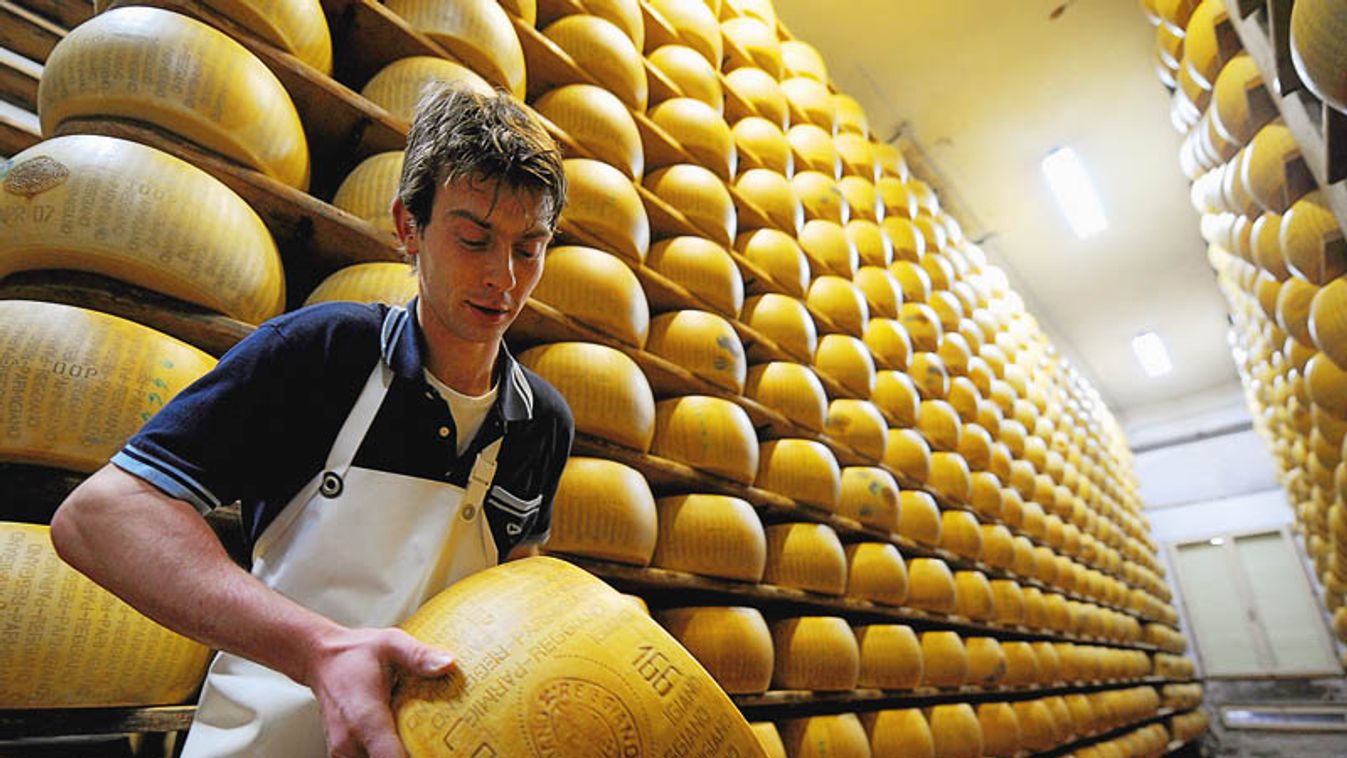Több tízmilliárdnyi sajt veszett kárba!
Újabb utórengések rázták meg Olaszország északi részét, ahol az elmúlt három hétben két nagy erejű földrengés 26 ember halálát okozta. Kisebb, 4-5-ös fokozatú rengés több száz történt ez idő alatt – és valószínűleg most is remeg a taljánok talpa alatt a föld.
Kép: A worker checks a wheel of seasoned Parmigiano Reggiano cheese in a factory in Valestra, near Reggio Emilia, Febuary 15 2008. Parmigiano-Reggiano is a grana, a hard, fat granular cheese, cooked but not pressed, named after the producing areas of Parma, Reggio Emilia, Modena, Bologna, in Emilia-Romagna, and Mantova in Lombardy. Parmigiano is simply the Italian adjective for Parma; the French version, Parmesan, is used in English. The term Parmesan is also loosely used as a common term for cheeses imitating true Parmesan cheese, especially outside Europe; within Europe, the Parmesan name is classified as a protected designation of origin. According to legend, the Parmigiano was created in the course of the Middle Ages in Bibbiano, in the province of Reggio Emilia. Its production soon spread to the Parma and Modena areas. Historical documents show that in the 13th-14th century Parmigiano was already very similar to that produced today: this suggests that its origins can be traced far before. In the European Union, "Parmesan" is a protected designation of origin (DOP); legally, it refers exclusively to the Parmigiano Reggiano DOP cheese manufactured in a limited area in Northern Italy.The name is trademarked, and in Italy there is a legal exclusive control exercised over its production and sales by the Parmigiano-Reggiano cheese Consorzio, which was created by a governmental decree. There are strict criteria each wheel must meet early in the aging process, when the cheese is still soft and creamy, to merit the official seal and be placed in storage for aging. AFP PHOTO / FILIPPO MONTEFORTE, Fotó: FILIPPO MONTEFORTE

A hivatalos adatok szerint 14 ezren váltak fedél nélkülivé, az olasz szakértők egyenesen földrengésválságról be¬¬szél¬nek. A Coldiretti, Olaszország agrártermelői szövetsége szerint a földrengéssorozat nyolcezer munkahelyet sodort ve¬¬szélybe az istállók, szántóföldek, öntözőberendezések megsemmisülése miatt.
A legnagyobb károkat azonban a parmezánsajtgyártók szenvedték el, mivel a rengések számos sajtkészítő üzemben is kárt tettek. A parmezán különös érték: Észak-Olaszországban hitelfedezetként ingatlan vagy ékszerek mel¬¬lett parme¬zán sajtot is elfogad több pénzintézet, a negyvenkilós sajtkorongokat egyenként háromszáz euróért számítják be. Becslések szerint a katasztrófában hatszázezer guriga sérült meg – a fenti árfolyamon ez 18 millió euró, avagy 54 milliárd forint. Ami csak töredéke az északolasz gazdaságok által elszenvedett, összesen 700 millió euróra becsült kárnak.
A gyártók, hogy mentsék a menthetőt, a szokásos ár feléért-harmadáért árulják most a sérült sajtok darabjait. Remélik, hogy e kiárusítással kereshetnek annyi pénzt, amivel helyrehozzák épületeiket, illetve friss alapanyagot, azaz tejet vásárolhatnak – tegyük hozzá: a tejtermelőket is jól megrázták a földrengések, elkel náluk is a pénz. Az összefogás nem hiábavaló: csak a Coldirettinek eddig mintegy 20 ezer rendelést küldtek e-mailen keresztül a parmezán szerelmesei a világ minden részéről – kelendő a „földrengett parmezán”.

